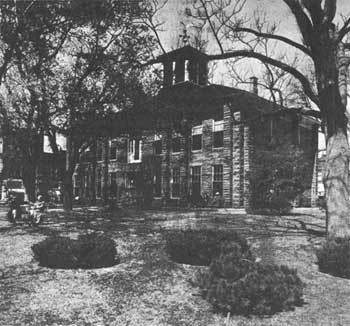





Survey of Historic Sites and Buildings
 |
CREEK NATIONAL CAPITOL Oklahoma |
 |
| ||
This building symbolizes the successful acculturation and political evolution of the Creek Indians, one of the Five Civilized Tribes, following their removal from the Southeastern United States to Indian Territory.
Between 1827 and 1830 some 2,000 to 3,000 Creeks moved voluntarily to Indian Territory, but the majority, opposing removal, remained in Alabama and Georgia. Between 1834 and 1838 the U.S. Government forcibly relocated those Creeks. Not long after the removal, the Upper and Lower Creeks united in name but in actuality remained separate. Each group had its own council, principal and second chiefs, and town chiefs. The town chiefs and the two principal chiefs, elected for life, met annually in a General Council, which enacted tribal laws. Town officials administered them.
Embittered, impoverished, and suffering from factionalism, most of the Creeks, who had emigrated emptyhanded and who failed to receive promised supplies and implements from the U.S. Government, found it difficult to adjust to their strange surroundings. Many who had lived comfortably in the East had to resort to primitive methods to build shelters and clear and cultivate land. Also feeling threatened by warlike tribes in the area, they clung to their traditional ways. The chiefs, who opposed Christian missionaries and education, penalized Creek converts heavily. Not until 1848 did the General Council approve missionary work. An exception to the general pattern of Creek life was one wealthy group, which patterned itself after the southern planter class and held vast acreages and large numbers of slaves.
 |
| Creek National Capitol. (photo Kent Spring, Creek Indian Memorial Association) |
In 1859 the Creeks began to reorganize their government. They held a democratic election to replace the two principal chiefs, who retired that year, and adopted a written constitution. Perhaps they might have undertaken more reforms had it not been for the Civil War, which created serious strife between the fullbloods and the mixed bloods; resulted in the battles of Round Mountain, Chusto-Talasah, and Chustenahlah; and hopelessly widened the division between the Upper and Lower Creeks.
After the war, in 1867, the Creeks united into a single "Muskogee Nation," and adopted a written constitution and code of laws based on the Government of the United States. Every 4 years the people were to elect a principal and second chief. The legislature, called the National Council, which was to meet annually in regular sessions, consisted of a House of Kings (comparable to the U.S. Senate) and a House of Warriors (resembling the U.S. House of Representatives). The National Council was charged with appointing members of the supreme court for 4-year terms. Other provisions of the constitution provided for district judges, attorneys, and policemen. That same year the tribe designated Okmulgee as its permanent capital and it remained so until about 1906, the year that the Curtis Act (1898) required the dissolution of tribal governments by the Five Civilized Tribes. The following year Oklahoma became a State.
An interesting sidelight of Creek political activity was the tribe's leadership in intertribal affairs among the Five Civilized Tribes and other tribes in Indian Territory. Before the Civil War, it had often called intertribal councils to discuss matters of common interest. In 1870, at one of these councils, delegates of the Five Civilized Tribes strengthened their 1843 Tahlequah compact, and formulated a plan to create a federal union in Indian Territory, similar to that of the United States. Although the U.S. Congress never approved this proposal, the council met annually for 5 years and solved many intertribal problems.
The first Creek capitol, erected at Okmulgee in 1868, was a two-story log structure that housed the legislature and the supreme court. In 1878 a new capitol, a native brown sandstone building of modified Victorian architectural style, replaced the log structure. From 1907 until 1916 the capitol served as the Okmulgee County Courthouse. Today owned and administered by the Creek Indian Memorial Association and in good condition, it features a museum of Creek history.
NHL Designation: 07/04/61
 |
 |
http://www.cr.nps.gov/history/online_books/soldier-brave/siteb23.htm
Last Updated: 19-Aug-2005